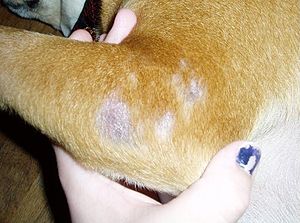Mange
| Mange | |
|---|---|
 |
|
| Dog with hair loss caused by demodectic mange | |
| Classification and external resources | |
| DiseasesDB | 33039 |
| eMedicine | article/1203895 |
| MeSH | D008924 |
Mange /ˈmeɪndʒ/ is a class of skin diseases caused by parasitic mites. Since mites also infect plants, birds, and reptiles, the term "mange", suggesting poor condition of the hairy coat due to the infection, is sometimes reserved only for pathological mite-infestation of nonhuman mammals. Thus, mange includes mite-associated skin disease in domestic animals (cats and dogs), in livestock (such as sheep scab), and in wild animals (for example, coyotes, cougars, and bears). Since mites belong to the arachnid subclass Acari (also called Acarina), another term for mite infestation is acariasis.
Parasitic mites that cause mange in mammals embed themselves either in skin or hair follicles in the animal, depending upon their genus. Sarcoptes spp. burrow into skin, while Demodex spp. live in follicles.
In humans, these two types of mite infections, which would otherwise be known as "mange" in furry mammals, are instead known respectively as scabies and demodicosis.
Also called demodicosis or red mange, demodectic mange is caused by a sensitivity to and overpopulation of Demodex canis. The two types of demodectic mange are localized and generalized. Localized consists of four spots or less. It is not contagious to humans.
Arthur Stanley Hirst, a noted authority on Acari states "In typical cases of this complaint the mites are found in enormous numbers, but Friedrich Gmeiner and also Albert E. Mettam have shown that D. canis is not the actual cause of follicular mange, which is due to a bacterium Staphylococcus epidermidis or some allied form. The mite plays an important part in the disease, however, by preparing the ground for the invasion of the bacterium by dilating the follicles and sweat-glands, and possibly also carries and introduces the germ. Whilst the Acari remain in the follicles or sweat-glands some of the bacteria may penetrate more deeply and be conveyed from one point to another by the blood-stream." - "Studies on Acari No. 1. The Genus Demodex, Owen"
...
Wikipedia
